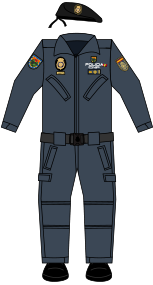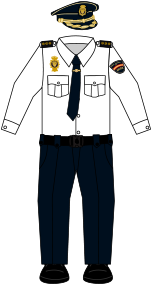National Police Corps (Spain)
This article needs additional citations for verification. (October 2011) |
| National Police Corps Cuerpo Nacional de Policía | |
|---|---|
Director-General | |
| Notables | |
| Anniversary |
|
| Award |
|
| Website | |
| www | |
The National Police Corps (Spanish: Cuerpo Nacional de Policía, CNP;
History
The 1986 organic law unifying the separate uniformed and plainclothes branches of the national police was a major reform that required a considerable period of time to be brought into full effect. The former plainclothes service, known as the Superior Police Corps (Cuerpo Superior de Policía), but often referred to as the "secret police", formerly the General Police Corps (Cuerpo General de Policía), consisted of some 9,000 officers. Prior to 1986, it had a supervisory and coordinating role in police operations, conducted domestic surveillance, collected intelligence, investigated major crimes, issued identity documents, and carried out liaison with foreign police forces.[2]
The uniformed service, the
The principal weapons regularly used by the uniformed police were 9mm pistols, 9mm submachine guns, CETME and NATO 7.62mm rifles, and various forms of riot equipment. Their original uniform consisted of light brown trousers and dark brown jackets.[2]
The initial training phase for recruits to the National Police Corps was nine months, followed by a year of practical training. Promotions to corporal, sergeant, and sergeant major were based on seniority, additional training, and performance. In the Franco era, most police officers were seconded from the Spanish Army (with some from the Civil Guard). Under a 1978 law, future police officers were to receive separate training, and army officers detailed to the police were to be permanently transferred. By 1986 only 170 army officers remained in the National Police Corps. Under the 1986 organic law, military-type training for police was to be terminated, and all candidate officers were to attend the Higher Police School at Ávila, which previously had served as the three-year training center for the Superior Police Corps. The ranks of the plainclothes corps—commissioners, subcommissioners, and inspectors of first, second, and third class—were to be assimilated into the ranking system of the uniformed police—colonel, lieutenant colonel, major, captain, and lieutenant. Two lower categories—subinspection and basic—would include all nonofficer uniformed personnel. The newly unified National Police Corps was to be responsible for issuing identity cards and passports, as well as for immigration and deportation controls, refugees, extradition, deportation, gambling controls, drugs, and supervision of private security forces.[2]
Franco's Policía Armada had once been dreaded as one of the most familiar symbols of the regime's oppressiveness. During the 1980s, however, the police underwent an internal transformation process, being brought to adopt the new democratic spirit of the times. The police supported the legally constituted government during the 1981 coup attempt. Led by the new police trade union, the police demonstrated in 1985 against right-wing militants in their ranks and cooperated in efforts to punish misconduct and abuses of civil rights by individual officers.[2]
The current sidearm is the
Duties
Duties are regulated by the Organic law 2/1986 of March 13, 1986.
- The issuing of identity documents – National ID cards and passports.
- To control receipts and outgoings of the foreign people and Spaniards.
- Immigration law, refuge and asylum, extradition and expulsion.
- Gambling enforcement
- Drug enforcement
- Collaboration with Interpol and Europol.
- Control of private security companies
- General law enforcement and criminal investigation.
Access and training
Requirements
- Be born or a naturalized Spanish citizen
- Be over 18 years of age.
- Be at least 1.65 metres (5 ft 5 in) tall, for men, and 1.60 metres (5 ft 3 in) for women
- Not have been convicted of fraud or dismissed by a local, regional or national government, or prevented from holding public functions.
- Hold a driving licenceof the class specified by the government.
Basic Scale:
- Have or to be in conditions to obtain the Certificate of Bachilleratoor equivalent.
Executive Scale:
- Have a Technical Engineer, Technical Architect, Qualified University student or equivalent or top formation degree.
Competitive examination
The applicant can choose between a Basic Scale career or an Executive Scale career. Applicants must pass the following basic tests before starting the academy:
- Physical test
- Multiple-choice exam
- Aptitude test
- Voluntary language test (English or French)
- Medical examination
- Interview
Training academy

If the applicant has been chosen, they will receive professional training at the police academy in
Ranks

From 1979 to 1986 the Police sported a military rank system, a holdover of the old Armed Police.
Above the cadet ranks (there are five cadet ranks), the current ranks are:
- Policía – Policeman/policewoman
- Oficial de Policía – Police Officer
- Subinspector – Sub-inspector
- Inspector – Inspector
- Inspector Jefe – Chief Inspector
- Comisario – Commissioner
- Comisario Principal – Principal Commissioner
- Jefe Superior – Superior Chief
- Comisario General – Commissioner General, and Jefe de División – Divisional Chief [equal ranks]
- Subdirector General – Sub-Director General
- Director Adjunto Operativo – Assistant Director of Operations
- Director General de la Policía – Director-General of Police
Rank insignia
Rank insignia 1986–2014
| Categories | Superior Grades | Superior | Executive | Deputy Inspector | Basic | Student | |||||||
|---|---|---|---|---|---|---|---|---|---|---|---|---|---|
Spain |
|||||||||||||
| DAO/Subdirector General | Comisario General/Jefe de División | Jefe Superior | Comisario Principal | Comisario | Inspector Jefe | Inspector | Subinspector | Oficial de Policía | Policía | Inspector Alumno de 2º año | Inspector Alumno de 1º año | Policía en Prácticas | |
| Superior | Executive | Deputy Inspector | Basic | ||||||
|---|---|---|---|---|---|---|---|---|---|
 |
 |
 |
 | ||||||
Uniforms
| CNP Uniforms | ||||||||

|

|

|

|

|

|

|

|

|
Service uniform
SC |
riot police
UPR |
riot police
UIP |
Tactical unit | Tactical unit | Bomb disposal | Dress uniform | Dress uniform | Dress uniform (female) |
| CNP Uniforms 1989–2009 | ||||||||

|

|

|

|

| ||||
| Service uniform | Service uniform | UIP/UPR | UIP 2000–2014 | GOES 1990–1995 | ||||
Specialist units
There are numerous specialist units within the CNP:
- GOES (Grupos Operativos Especiales de Seguridad) – police tactical units.
- GEO (FBI HRT.
- TEDAX-NRBQ (Servicio de Desactivación de Explosivos y Nuclear, Radiológico, Bacteriológico y Químico) – Explosive artifacts defuser and CRBN (Chemical, Radiological, Biological, and Nuclear) specialised team.
- UIP (Unidad de Intervención Policial) – Anti-riot unit.
- UPR (Unidad de Prevención y Reacción) – Anti-riot unit.
- UDYCO (Unidad de Drogas Y Crimen Organizado) – Drugs and organised crime investigation squad.
- UDEV (Unidad de Delincuencia Especializada y Violenta) – Investigation and pursuit several kinds of crimes related to artistic and cultural heritage, families.
- BIT (Brigada de Investigación Tecnológica) – Computer crime unit.
- UDEF (Unidad de Delincuencia Económica y Fiscal) – Financial crimes.
- UEGC (Unidad Especial de Guías Caninos) – Canine unit. Drug, explosives and people detection.
- CGPJ (General Commissariat of Judiciary Police) – intelligence unit.
- CGI (General Commissariat of Information) – intelligence and anti-terrorism unit.
- SMA (Servicios de Medios Aéreos).
- USPA (Unidad de Subsuelo y Protección Ambiental).
- TEDAX
- GOIT (Grupo Operativo de Intervenciones Técnicas).
- GOR (Grupo Operativo de Respuesta).
- Unidad Canina – Canine unit
Gallery
-
Eurocopter EC120
-
VAMTAC
See also
References
- ^ Ley Orgánica 9/2015, de 28 de julio, de Régimen de Personal de la Policía Nacional (Ley 9) (in Spanish). 2015.
- ^ LCCN 90006127.
 This article incorporates text from this source, which is in the public domain. Country Studies. Federal Research Division.
This article incorporates text from this source, which is in the public domain. Country Studies. Federal Research Division.
External links
- Official website
- Spanish police forces forum The most complete forum about different Spanish police forces.



































